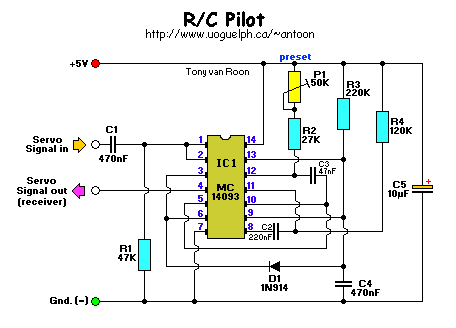
Parts List:
Resistors are 1/4W, 5% tolerance
R1 = 47K C1,C4 = 470nF, ceramic
R2 = 27K C2 = 220nF, ceramic
R3 = 220K C3 = 47nF, ceramic
R4 = 120K C5 = 10uF/10V, electrolytic or tantalum
P1 = 50K D1 = 1N914
IC1 = MC14093
If you wish to purchase a full KIT, please Click Here: RC Pilot KIT
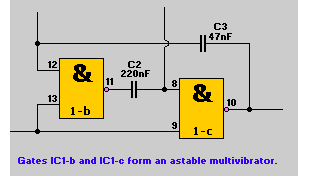
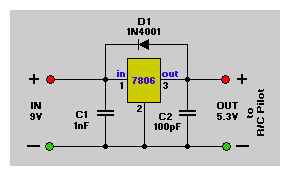 Description:
Description:
The Radio Control Pilot is a circuit build around the Motorola CMOS MC14093, which has four Schmitt-trigger NAND gates.
Click on the MC14093 if you need a data sheet.
Gates 1a and 1b form a astable multivibrator to create the necessary pulses for the servo. However, when a transmitter
signal via the receiver is present on the input, the multivibrator is idle and does not work. It just passes the input
signal back to the output on pin 4 of the 14093 as usual. If the transmitter signal to the receiver (and hence to the
servo) is absent, the multivibrator starts to work and puts the servo in a pre-set position adjustable with P1.
You may for instance want to put the R/C Pilot on ailerons and so when there's no signal the aircraft slowly banks in
circles until it comes down on its own.
The working voltage for this circuit is from about 3 to 9Vdc, although the CMOS IC itself can handle voltages up to
18V. This means that a 9V NiMh battery and a 6-volt regulator would work good for this circuit. You can use a regular
9V alkaline battery also, it is just heavier in weight and is not rechargeable. Diode D1 takes 0.7V and so there is a
steady 5.3V left to do the job for a long time(see diagram at the right).
To make it work with the r/c pilot, tie the negatives (-) from the Rx battery pack, the volt regulator circuit, and the
r/c pilot circuit together. Again, ONLY the negative! Leave the positives (+) for each circuit as shown. (follow diagram)
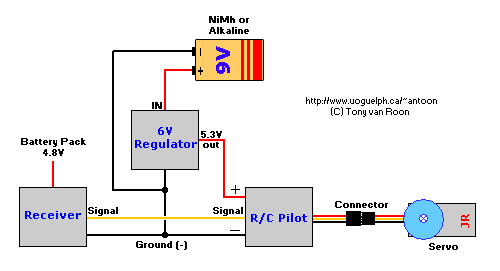
Being in to radio control since the mid 70's, I've seen weird accidents happen at the flying field. One such occurrence
was a fast flying piper cub, losing its receiver battery during an awkward snap-roll to the left. With no power to the
receiver and the throttle stuck almost full throttle, the plane kept violently climbing higher and higher, in a sharp
left turn, for at least 15 minutes or so until all the fuel was burned up. By that time the plane was so high it was
only a speck and barely visible only by very good eyes. Assuming the plane was lost and crashed into pieces somewhere
my distraught buddy and his son went home. At the club meet that same week he explained that while driving home his
son yelled: "Dad, there it is! There, in that farmers field!"
So what happened? As luck would have it, the plane came down the same way it went up, but gliding in a slow left turn
until it just touched down in that farmers field just a kilometer down the road. Other than smudged with fuel and sand
it didn't have a scratch! On top of all the 'luck', there was no wind that day whatsoever. What an amazing event.
Of course the R/C Pilot will not work without power. That's why I always make sure, *before* each flight, that my radio
gear is 100% secure and the battery packs fully charged. Fresh elastics will keep the receiver in its place. No
exceptions! Don't ever make the mistake to "make a quick flight" with the battery pack almost empty. You're asking
for trouble. You know Murphy's Law: "If something can go wrong, it will!"
You may want to run the R/C Pilot off its own power source. Best to be light weight of course. NiMh would be
preferable. No NiCads. They are just too clumsy, not enough juice, and unreliable. As a matter of fact, why not
upgrade your Rx battery pack to NiMh? Keep the old NiCad charged and well kept as a backup. Works for me.
For those of you wanting a printed circuit board and parts layout, I made it available below. The circuit board is
NOT for sale on its own, only with a complete kit. So don't ask.
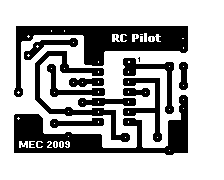
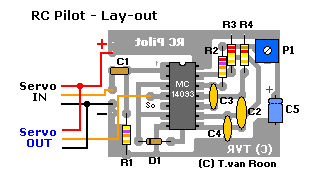
Please note that the pcb was modified again to eliminate Jumper J1. The layout diagram at the right has also been
updated.
Back to Gadgets Menu page
Page copyright © 2006, Tony van Roon.
Original drawing copyright Elektor Magazine.






